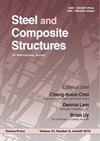Seismic performance of steel columns corroded in general atmosphere
IF 3.9
3区 工程技术
Q1 CONSTRUCTION & BUILDING TECHNOLOGY
引用次数: 1
Abstract
Steel structures exposed to general atmosphere for a long time are highly susceptible to corrosion damage, which would lead to the degradation of service performance of the components and even structures. This article focuses on the effect of corrosion on the seismic performance of steel column. The accelerated corrosion tests in general atmosphere were conducted on 7 H-shaped steel columns and 20 steel plates. Then the obtained plate specimens were subjected to monotonic tensile tests and cyclic loading tests, and the steel columns were subjected to pseudo-static tests, respectively, to study the effects of corrosion on their mechanical properties and seismic performance. Then, a simplified three-dimensional finite element model (FEM) capable of accurately simulating the hysteretic response of corroded steel columns under low-cycle loading was established. Experimental results indicated that the yield strength, tensile strength, elastic modulus and peak strain of corroded steel plate decreased linearly with the proposed corrosion damage parameter Dn, and the energy dissipations under low-cycle loading were significantly reduced. There is a correlation between the cyclic hardening parameters of corroded steel and the yield-tensile strength difference (SD), and then a simplified formula was proposed. Corrosion could result in the premature entrance of each loading stage of corroded columns and the deterioration of buckling deformation range, bearing capacity and energy dissipation, etc. In addition, a larger axial compression ratio (CR) would further accelerate the failure process of corroded columns. The parametric finite element analysis (FEA) indicated that greater damage was found for steel columns with non-uniform corrosion, and hysteretic performance degraded more significantly when corrosion distributed at flanges or foot zone.一般大气中腐蚀钢柱的抗震性能
钢结构长期暴露在大气环境中,极易发生腐蚀损伤,导致构件甚至结构的使用性能下降。本文主要研究腐蚀对钢柱抗震性能的影响。对7根h型钢柱和20块钢板进行了一般气氛加速腐蚀试验。然后对得到的钢板试件分别进行单调拉伸试验和循环加载试验,对钢柱进行拟静力试验,研究腐蚀对钢柱力学性能和抗震性能的影响。在此基础上,建立了能准确模拟低周荷载作用下腐蚀钢柱滞回响应的简化三维有限元模型。试验结果表明,腐蚀钢板的屈服强度、抗拉强度、弹性模量和峰值应变随腐蚀损伤参数Dn的变化呈线性下降,低周加载下的能量耗散显著降低。建立了腐蚀钢的循环硬化参数与屈服-拉伸强度差(SD)之间的关系,并提出了简化公式。腐蚀会导致腐蚀柱提前进入各加载阶段,并导致屈曲变形范围、承载力和耗能等性能的恶化。此外,较大的轴压比(CR)将进一步加速腐蚀柱的破坏过程。参数化有限元分析结果表明,非均匀腐蚀的钢柱损伤更大,当腐蚀分布在法兰和脚区时,钢柱的滞回性能下降更明显。
本文章由计算机程序翻译,如有差异,请以英文原文为准。
求助全文
约1分钟内获得全文
求助全文
来源期刊

Steel and Composite Structures
工程技术-材料科学:复合
CiteScore
8.50
自引率
19.60%
发文量
0
审稿时长
7.5 months
期刊介绍:
Steel & Composite Structures, An International Journal, provides and excellent publication channel which reports the up-to-date research developments in the steel structures and steel-concrete composite structures, and FRP plated structures from the international steel community. The research results reported in this journal address all the aspects of theoretical and experimental research, including Buckling/Stability, Fatigue/Fracture, Fire Performance, Connections, Frames/Bridges, Plates/Shells, Composite Structural Components, Hybrid Structures, Fabrication/Maintenance, Design Codes, Dynamics/Vibrations, Nonferrous Metal Structures, Non-metalic plates, Analytical Methods.
The Journal specially wishes to bridge the gap between the theoretical developments and practical applications for the benefits of both academic researchers and practicing engineers. In this light, contributions from the practicing engineers are especially welcome.
 求助内容:
求助内容: 应助结果提醒方式:
应助结果提醒方式:


